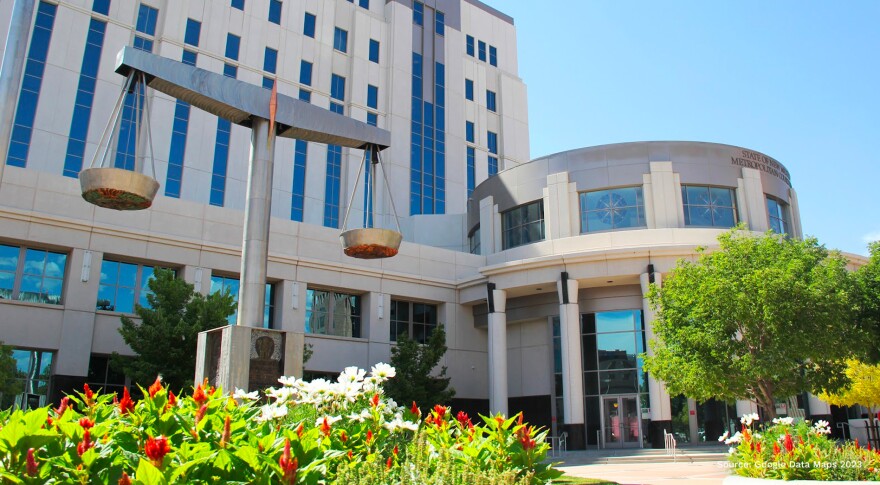The New Mexico Supreme Court on Monday limited how many people can enter three court buildings in the Albuquerque area after the county sheriff’s office reduced the number of deputies it assigns for security, it said.
Officials with the state’s judicial branch say the security cuts come as violence toward court staff and judges are on the rise. A news release by the state Administrative Office of the Courts noted a melee earlier this year in which family members beat a defendant and a jail guard during a hearing, as well as one last week in which “several members of the district attorney’s office were verbally accosted and confronted on their way to a parking lot after a court hearing.”
The Bernalillo County Sheriff’s Office on July 10 notified the Second Judicial District Court that it planned to reduce security personnel at court locations effective July 21, because of “budget constraints,” according to the AOC news release. Specifically, AOC Barry Massey told Source in a written statement, the sheriff’s office informed the court it was capping the number of deputies assigned to the court’s three locations at 14, below past staffing levels at the court.
A request for comment to a spokesperson for the sheriff’s office, and a voicemail for Sheriff John Allen, were not returned as of Monday afternoon. The Albuquerque Journal reported Allen denied reducing staff.
AOC said the Supreme Court ordered most hearings in civil, family and children’s court cases in Bernalillo County to be held online rather than in-person.
“The safety and well-being of people required to go to court cannot be compromised,” Supreme Court Chief Justice David K. Thomson said in a statement. “We value our partnership with the County of Bernalillo and especially the hard work and dedication of officers assigned to the courthouse. However, our paramount concern is protecting jurors, witnesses, victims and their families, attorneys, court employees, judges and members of the public who come to the district court for trials, hearings and other court business.”
Massey told Source the court is “focusing on working with BCSO and Bernalillo County to provide necessary security.”
Sen. Antoinette Sedillo-Lopez (D-Albuquerque), who serves on the Legislature’s interim Courts, Corrections & Justice Committee, said she hadn’t been aware of the staffing issue prior to Source’s request for comment. She said she sees the situation as one that reduces people’s access to justice.
“The Legislature should address this and other courthouse access issues,” Sedillo-Lopez said in an emailed statement. “Our courthouses must be available for access to justice for all people.”
The committee heard a presentation on the topic of courthouse security earlier this month, and Camille Ward, a spokesperson for the Democratic majority in the state House of Representatives, told Source NM on Monday the issue will be back on the committee’s agenda next week.
The justices as of Monday also limited operating hours of the court clerk’s office and the domestic violence clerk’s office at the Bernalillo County Courthouse. Clerks will continue to respond to phone calls and electronic court filings, the AOC said.
People will no longer be able to enter the courthouse to use the self-help center; however, it will still accept inquiries via email or by phone at (505) 841-6702.
The changes are temporary through Aug. 2, the AOC said in its news release. “We must take these precautionary steps while the district court works with Bernalillo County and its sheriff’s office to restore security staffing to necessary levels,” Thomson said.
Jury trials in criminal and civil cases — along with some other criminal proceedings such as sentencing hearings — will continue to be held in-person, the AOC said. Jurors must still report to the courthouse for jury selection and trials, and the changes do not affect the Bernalillo County Metropolitan Court.
Guarding the courthouseState law requires the 33 local county governments to provide security in district courts.
In the case of Bernalillo County, the county owns the courthouse, the Juvenile Justice Center that houses the Children’s Court and the Public Safety Center where people report to pretrial services and treatment courts, the AOC noted, and the Bernalillo County Sheriff’s Office is responsible for providing security. That entails screening people who enter the courthouse; responding to judges’ and court staff’s duress alarms when people pose threats; and intervening in courtroom disruptions and physical fights in court buildings. So far this year, there have been 5,867 calls for service to deputies working court security, the agency said.
In his statement, AOC spokesman Massey noted that Bernalillo County’s three court locations “are blocks apart and the main courthouse has seven floors with multiple courtrooms. This illustrates the challenge in responding to more than one altercation or threat at the same time in one or more of the district court’s locations.” By any measure, Massey added, “security staffing at the Second Judicial District Court remains inadequate for the state’s busiest district court.…court hearings often are emotionally charged and contentious. Underestimating the court’s security needs can lead to serious harm or tragedy.”
During her presentation to lawmakers, Cynthia Pacheco, director of the Court Operations Division at AOC, included U.S. Marshals Service data showing a 104% increase in threats to judges nationwide between 2021 and 2024, noting spikes in threats during elections and politicized cases.
She told lawmakers she believes the judiciary statewide needs at least 150 security staff, and suggested they consider creating a new state court marshal’s service. She previously told Source NM her agency has started talking with court systems in Oregon and Maine that have established their own state court marshals. In magistrate and appeals courts, either the AOC or the appeals courts themselves pay for security, she said.
Evan West, chief marshal for the Oregon Judicial Department’s Marshal’s Office, told Source NM on Monday that he briefed James Noel, a district court judge in New Mexico’s Thirteenth Judicial District, about Oregon’s court marshals, which were created under a different name in 2005.
Oregon’s court marshals work security in appeals courts while 36 local sheriff’s offices provide transport and security to trial courts, West said. They now train sheriff’s deputies on planning for high-risk trials; conflict simulation; deescalation; dealing with sovereign citizens; and interacting with judges, court staff and the public, he said.
“It’s not an easy process to stand up and take on court security when that’s not the way it’s been done,” West said. Illinois, Florida and Connecticut are also considering their own court marshal’s services, he added.
Barbara Cardone, director of legal affairs and public relations at the Maine Administrative Office of the Courts, told Source NM on Monday that Maine used to have a similar court security system to New Mexico’s until it switched to a statewide court marshal’s service in the mid-2000s.
“We consider having gone to a judicial statewide marshal service to be a much better option for our state,” Cardone said in an interview. “Having the judicial marshal’s service that is specializing in courthouse policing and security, I think, has given us a more developed standard of policing in that area, rather than just having either retired deputies filling in or people rotating in from being out on the beat.”
Both Cardone and West said courthouse policing is different from regular policing, though it involves a similar set of skills.
“The focus isn’t on going out and arresting people or looking for breaking laws,” Cardone said. “Their focus is on security, on keeping people safe and on understanding the techniques necessary to do that.”



